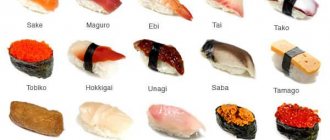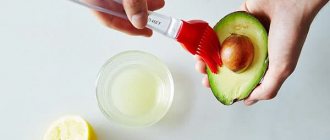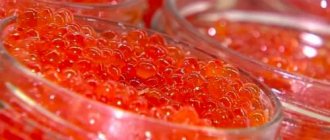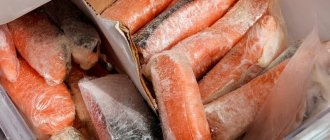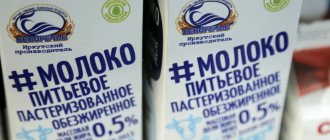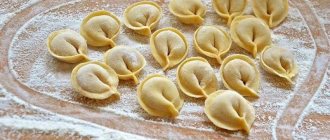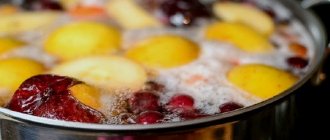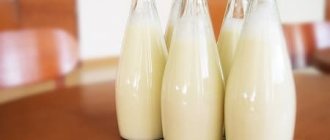In 1867, Swiss pharmacist Henri Nestlé developed the first adapted infant formula. His invention has been used for more than 100 years to feed babies when breastfeeding is impossible and insufficient. Today, young parents have become more mobile and often travel with their children. It is important for them to organize their baby’s meals correctly, without harm to health, which is why many inexperienced mothers ask on forums how long the diluted formula can be stored in a bottle.
Let's find out!
Divorced
In a refrigerator
The finished mixture, placed in a bottle at a temperature of +2 to +4°C (in a refrigerator), will retain its beneficial properties throughout the day.
The middle shelf of a refrigerator cabinet is best suited for placement, but using the door is strictly prohibited.
At room temperature
Diluted infant formula in the room can be used to feed an infant within 3 hours of preparation.
In this case, it is necessary to ensure a temperature regime of no more than +24°C, seal the bottle or other storage container, and exclude exposure to sunlight. Special thermal bags or thermal bags are well suited for transportation.
In a situation where you need to take food for the baby with you, but feeding is planned later than 3 hours after dilution, it is better not to dissolve the contents of the jar in water, but take separately the mixture in a sterilized package and warm water in a thermos. Before your baby's next meal, simply pour the powder into water and shake thoroughly.
In the freezer
Unlike breast milk, it is prohibited to freeze adapted infant formula.
This product should not be given to infants, since its quality is significantly reduced, the taste deteriorates and can have serious consequences for the child’s health.
Note to moms
You already know that in the finished product for artificial feeding of children, dangerous bacteria tend to multiply quickly. We bring to your attention some useful tips, following which you can protect your baby from eating spoiled or stale food. Utensils necessary for feeding formula-fed children:
- 3-4 bottles, the nipples of which can be closed with a cap;
- thermos – container for baby food;
- cooler bag for walking and leaving the house;
- water heater for baby food.
Let's answer the question: Is it possible to use garlic while breastfeeding?
Place the freshly prepared product in the refrigerator; some people find it convenient to pour the contents right away or store it in a measuring cup, reheating it as much as necessary. The baby's new dishes must be boiled for at least 30 minutes to prevent foreign substances from entering the child's body. We leave the clean dishes on the table, covering the top with a sterile bandage or gauze. For long walks or trips to the clinic, take with you a regular thermos with boiling water poured into it. Regardless of where you are, at any time you will feed your child, and the food will be fresh, which means healthy and safe. In a refrigerator bag you can store a container with a ready-to-use mixture; for this it is better to have a small electric heater that will prepare the food by heating it to the required temperature.
Open and closed packaging
Factory
In closed containers, products can last for several years. The most well-known manufacturers have established the following expiration dates for their products:
- 18 months – Nutrilon Comfort, Nan Optipro, Nutrilak, Hipp, Malyutka.
- 24 months – Frisolak, Nestozhen, Frisovo, Bellakt, Similak Premium.
- 3 years – Nanny.
Recommended storage conditions in sealed packaging: temperature range from 0 to +25°C, relative humidity no more than 75%.
Opened
The vast majority of manufacturers set the shelf life after opening the package to no more than 3-4 weeks. From the point of view of economy, it is more profitable to take brands with a shelf life of 1 month for open containers: during this time you can manage to use up all the contents of the box. However, it should be remembered that the vitamins, minerals and other beneficial elements contained in the composition are destroyed when in contact with air. In this regard, the nutritional value in the opened container gradually decreases.
Lure
In the case of artificial feeding, complementary foods are introduced no earlier than 6 months. It is worth relying on the child’s age and readiness to introduce new food.
This can be determined by the following signs:
- baby sits confidently
- doubled my weight since birth
- does not push food out with tongue
- shows interest in adult food
Input rules:
- one product at a time. If we start with vegetables, then there is no need to mix them all at once, one is enough, then we observe the baby’s reaction, whether there will be allergies or gastrointestinal disorders
- the interval between the introduction of new products is 5-7 days.
- offer complementary foods before the main meal
Before introducing complementary foods, consult your pediatrician.
What do the deadlines depend on?
The composition of the adapted mixture includes a number of important micro- and macroelements, vitamins, and minerals that the newborn’s body so needs. These components help the correct formation and development of all internal organs and systems of the baby. But, as you know, many vitamins can be destroyed if storage rules are not followed and if they are exposed to ultraviolet rays.
In addition to these facts, various pathogens and bacteria pose a direct threat: a dairy product can become an excellent environment for their reproduction.
Based on these data, the manufacturer sets the expiration date, guaranteeing the quality and safety of the product only if all the necessary requirements specified in the annotation are met.
Things to Remember
- Always hold your baby firmly in your arms while he or she eats.
Try not to disturb or move your baby while feeding, otherwise he may choke.
- Check diapers
If your child pees less than usual, you should consult a doctor. This may indicate dehydration or lack of nutrition.
- Make sure the nipple hole is the right size
When it is too wide, the baby will choke and cannot keep up with the rapid flow of milk. If your baby is tense and trying too hard, the hole is probably too small and the nipple is too hard. Correct the situation, since it is difficult for the baby to get food, he may get tired and remain hungry.
Recommendations
In order for a product intended for baby food to last as long as possible and retain its beneficial qualities, you must adhere to the following recommendations:
- Pediatricians do not advise purchasing a product with a borderline expiration date. Always pay attention to the period indicated on the packaging to see if it is coming to an end.
- After each use, tightly close the container with a lid and keep it in a dry, dark, cool place away from windows, stove, radiator, and moisture.
- Use the opened mixture no later than 3-4 weeks (check the label for the exact period). To remember when the container was opened, make a mark on the lid with a marker.
- Avoid proximity to flour and cereals, which can become a source of insect infestation.
- Do not place the product in a dry state in the refrigerator or freezer, as the powder will quickly become damp and absorb foreign odors.
- Do not use expired product.
- Always wash your hands thoroughly before dilution, and also sterilize all utensils necessary for preparation (bottles, nipples, spoons).
- Do not store leftover food after your baby’s next meal (if he hasn’t finished eating), but rather dispose of it.
- Some manufacturers use cardboard boxes for packaging to reduce costs. It is better to pour the contents from such containers into a vacuum bag or container to reduce the risk of oxidation.
- Always check the container for leaks before purchasing.
These easy-to-follow tips will help you preserve valuable properties and prepare baby food that meets safety and quality requirements.
2.How to properly dilute formula for newborns?
2.1. How to dilute the mixture
- Carefully read the manufacturer's instructions for preparing the mixture; this will not only help you prepare a tasty drink, but also save your baby from many problems that arise from parental inattention.
- Follow the manufacturer's recommendations regarding the proportions of dry mixture and water. Both a lack of formula and its excess can harm the baby. The formula dilution tables are compiled taking into account the nutritional value of the product and the age needs of children. Your doctor will create a diet tailored to your baby's needs.
- First, water is poured into the bottle, then the mixture is added! Not the other way around.
- Do not shake the mixture too much! This leads to the formation of foam, which, when it enters the baby’s mouth, causes increased gas formation.
- It is best to stir the mixture with rotational movements at least 15-20 times (circles), it is better to hold the bottle vertically.
- White lumps on the walls of the bottle are a common occurrence and can be associated, among other things, with different water that is used in the laboratory when formulating and the water at home. Animal milk, depending on the time of year, may also differ slightly in its organoleptics and composition, but this also affects the breedability of the product. The water temperature here is critical, but few people use a thermometer when preparing the mixture; however, pieces of fat can remain on the walls of the bottle even with a small difference between the recommended and actual cooking temperature.
- If you plan to feed your baby while out for a walk, then take with you dry formula in a special container and a thermos with water heated to the required temperature. Mix a portion of the formula before feeding your baby.
- Before feeding, ALWAYS check the temperature of the formula by dropping it on the back of your hand - the mixture should be nice and warm, not hot or cold.
- Do not mix different formulas in the same bottle, even if they are different mixtures, for example, different formulas from the same manufacturer. An exception may be some medicinal mixtures that can be added to the main mixture. Such food is prepared only on the recommendation of the treating pediatrician.
2.2. Can the mixture be heated? How to properly heat the mixture?
- It is better not to heat the prepared diluted mixture.
- Reheating in a microwave, if you cannot control the heating temperature, can be dangerous for the child due to uneven heating.
- Any heating of the mixture above the dilution temperature reduces the nutritional value of the product, because not all ingredients can withstand heat treatment.
- It is better to heat the water for preparing the mixture, rather than the finished mixture.
- Prepare the mixture immediately before feeding, this will help keep the drink at a comfortable temperature.
- If you still need to heat the mixture, it is better to do this in a water bath or under running hot water.
- You can purchase a bottle warmer; read the instructions carefully before heating the formula or water to prepare the formula. Read reviews from moms.
- It is not recommended to reheat the mixture left over from the previous feeding; it is better to prepare a new portion. In the remainder of the mixture, microbiology is quickly disrupted, and some nutrients simply evaporate. Manufacturers do not recommend storing ready-made mixtures for more than 20-40 minutes. In maternity hospitals this is a necessity, at home it is better to avoid this.
- Don't forget to test the temperature of the formula on your hand before feeding your baby!
2.3. How long to store the diluted mixture?
- Manufacturers do not recommend storing ready-diluted mixtures for more than 20-40 minutes. In maternity hospitals this is a necessity, but at home it is better to avoid it.
- Try to prepare the formula for one feeding; if the child has not finished the formula, it is better to pour it out and prepare a new formula for the next feeding.
ATTENTION: The information is for informational purposes only, all children are individual, be sure to consult your treating pediatrician for any questions about your baby’s nutrition and health. Breast milk is the best nutrition for your baby.
Share on social media networks
